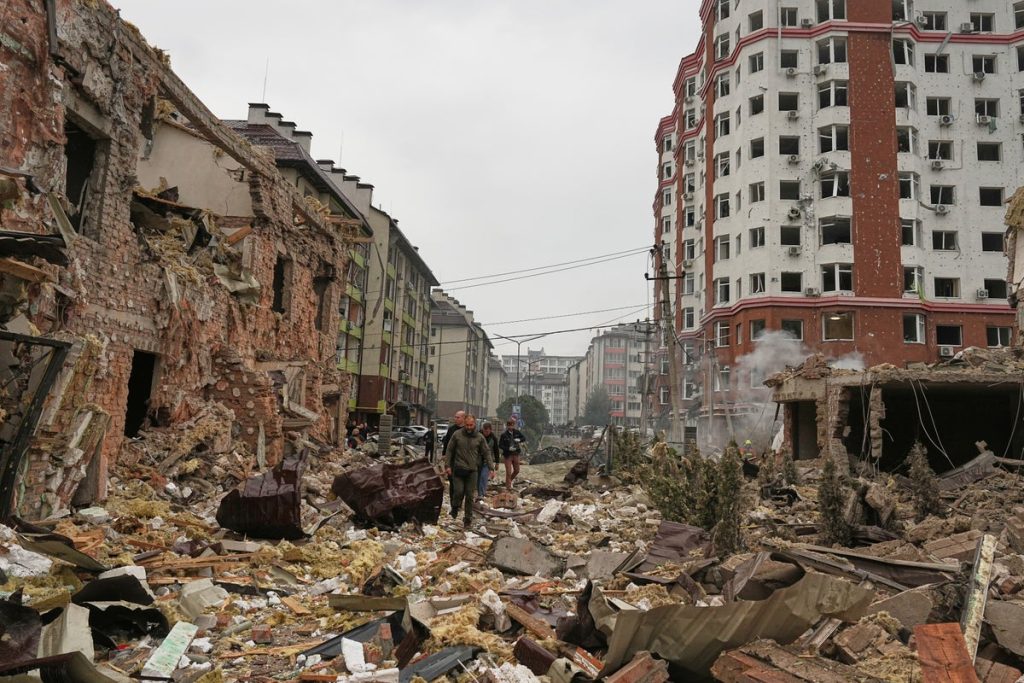Destruction in Kyiv After Deadly Russian Attack
In the early hours of September 28, 2025, the Ukrainian capital, Kyiv, experienced one of the most devastating assaults since the onset of hostilities. The attack, characterized by a combination of missiles and drones, has drawn international condemnation and raised alarms about the region’s security.
The Scale of the Attack
Ukrainian President Volodymyr Zelensky reported that approximately 500 drones and 40 missiles were launched toward key cities, with Kyiv suffering particularly severe consequences. The airspace overhead was filled with explosions, causing thick black smoke to plummet from vital infrastructure and residential areas. Local officials reported that at least four people, including a 12-year-old girl, lost their lives as a consequence of the strikes. Additionally, injuries spanned across the country, with a rising count of over 70 wounded, many of whom were civilians.
Reactions from Kyiv’s Leadership
President Zelensky did not hold back in condemning the violent nature of the strikes, terming them “vile” and indicative of a targeted assault against ordinary citizens. He emphasized the deliberate strategy behind the attack, pointing to the numerous civilian sites—such as residential buildings and even kindergartens—that were hit. Kyiv Mayor Vitali Klitschko confirmed that damage assessments indicated widespread devastation across more than 20 locations in the capital.
Military Responses and Regional Implications
The Russian military publicly claimed responsibility for what they termed a “massive strike,” asserting that their focus was on military airfields and other strategic installations in Ukraine. This rhetoric starkly contrasts the reality faced by civilians who find themselves under the constant threat of bombardment. The assault disrupted the already fragile security infrastructure, prompting Poland to scramble fighter jets as a precautionary measure, highlighting fears of potential wider conflict.
International Reactions
The international community is now on high alert in response to these developments. As Ukrainian officials continue to plead for heightened global support, the attack raises profound concerns about Russian intentions and the stability of European security models. Zelensky called on world leaders to support ongoing sanctions against Russia, particularly regarding energy exports that have financed this conflict.
Visual Impact of the Assault
Multiple eyewitness accounts and journalistic reports illustrate a grim scene across Kyiv. Streets littered with debris, emergency services overwhelmed with calls, and families displaced by the destruction have painted a harrowing image of life in the city. Residents have been seen sifting through rubble while others sought refuge underground, revealing a society on the brink of emotional and psychological fatigue.
The Broader Context
The September 28 attack follows closely on the heels of international diplomatic engagements, including Zelensky’s meetings with global leaders, seeking renewed commitments for aid and support. The backdrop of these negotiations emphasizes the ongoing complexities faced by Ukraine, not just militarily but economically as well. The relationship with neighboring countries has become increasingly strained, particularly with assertions of cross-border military engagements and NATO’s response strategy being scrutinized.
A Grieving Nation
As Ukraine grapples with the fallout from this assault, a collective mourning permeates the air. The loss of life, especially of children, weighs heavily on the national psyche, broadening the narrative beyond mere statistics to human stories of grief and resilience. Memorials and vigils are bound to sprout across the cities, reflecting the unity and strength of a community facing unyielding challenges.
These episodes of violence instill a sense of urgency within the global political framework, with many wondering how long Ukraine can withstand such relentless aggression while calling for an urgency in providing support.
As the situation evolves, the ramifications of this “massive attack” reveal not only the immediate crises but also the long-term implications for Ukraine and the broader geopolitical landscape.

